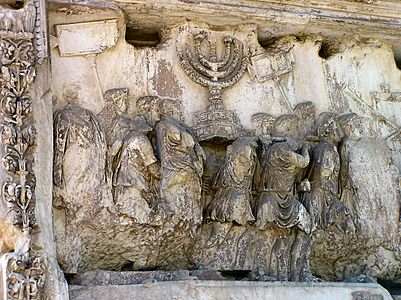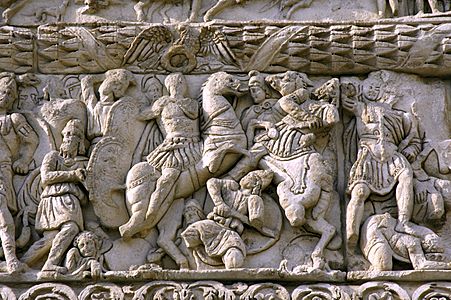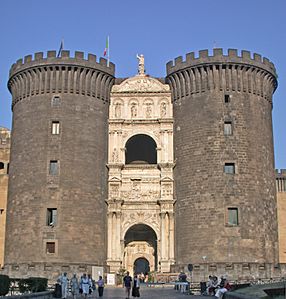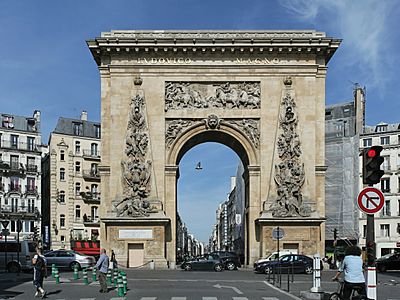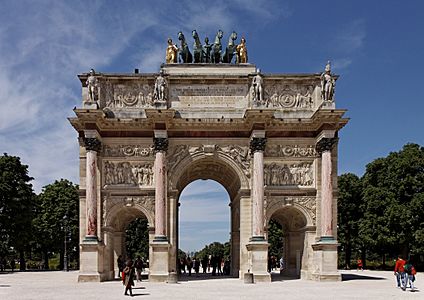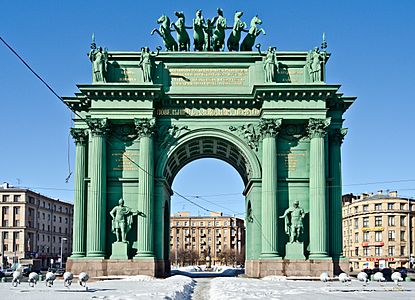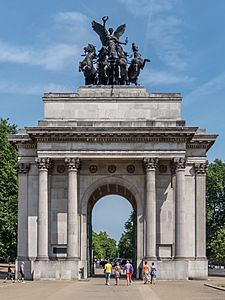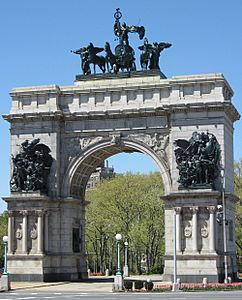Triumphal arch facts for kids
A triumphal arch is a large, stand-alone archway. It often has one or more arched openings. These arches were usually built to go over a road. In its simplest form, a triumphal arch has two big pillars connected by an arch. On top, there's a flat section called an attic. This attic might hold a statue or special messages. The arch is often decorated with carvings and sculptures. Some arches have many archways.
Triumphal arches are a famous type of building from ancient Rome. The Romans likely invented them. They used these arches to celebrate winning generals or important public events. These events could be starting new towns, building a road, or a new emperor taking power.
Many Roman triumphal arches still stand today. Examples include the Arch of Titus and the Arch of Constantine. These old arches have inspired many countries and rulers since Roman times. People around the world have built their own triumphal arches. Famous ones include the Arc de Triomphe in Paris and the Wellington Arch in London.
It's important not to confuse triumphal arches with other types of arches. Some arches, like the Brandenburg Gate in Berlin, look similar. However, they are built for different reasons. They might remember war victims or celebrate a country's independence. True triumphal arches celebrate military success or a general.
Contents
The History of Triumphal Arches
How Roman Arches Began
The idea of the triumphal arch is strongly linked to ancient Roman architecture. Romans were skilled at using arches in buildings like aqueducts and bridges. They probably learned how to build arches from their neighbours, the Etruscans. The Etruscans used decorated arches as city gates. You can still see Etruscan arches in places like Perugia.
The Roman triumphal arch combined two main parts: a round arch and a flat top section. The ancient Greeks used these parts separately. But the Romans put them together in one stand-alone structure. What were once supporting columns became decorations on the arch's outside. The flat top became a place for statues and messages. These messages shared the builders' civic and religious ideas.
The name "triumphal arch" comes from the Roman practice of a "triumph." A triumph was a big parade given to successful Roman generals. The Roman senate voted to award these honors. The earliest arches built for triumphs were from the time of the Roman Republic. These were called fornices. They showed pictures and stories of the victory. For example, Lucius Steritinus built two fornices in 196 BC. He built them to celebrate his wins in Hispania.
Arches in the Roman Empire
Roman triumph traditions changed when the Empire began. Emperor Augustus decided that only members of the Imperial family could have triumphs. This usually meant the emperor himself. The word fornix was replaced with arcus (arch). Republican fornices could be built by a general using his own money. But Imperial triumphal arches were paid for by the senate. They were built to honor emperors and their power. These arches were often built across roads. People were meant to walk through them, not around them.
Most Roman triumphal arches were built during the Imperial period. By the 300s AD, Rome had 36 such arches. Three of them still stand today. These are the Arch of Titus (built 81 AD), the Arch of Septimius Severus (203–205 AD), and the Arch of Constantine (315 AD). Many arches were also built in other parts of the Roman Empire.
The single arch was the most common type. But many triple arches were also built. The Triumphal Arch of Orange (around 21 AD) is the oldest surviving triple arch. From the 200s AD, many arcus quadrifrons were built. These were square arches with openings on all four sides. They were often built over crossroads, especially in North Africa. Building arches in Rome slowed down after Emperor Trajan (98–117 AD). But it continued in the provinces during the 200s and 300s AD. These arches often celebrated visits from the emperor.
We don't know much about how Romans thought of triumphal arches. Pliny the Elder, a writer from the 1st century AD, was the only ancient author to discuss them. He wrote that they were meant to "lift above the ordinary world" an image of an honored person. This person was usually shown in a statue with a quadriga (a chariot pulled by four horses).
What Roman Arches Looked Like
The decorations on an arch were a constant reminder of the victory and the general. They showed real events rather than made-up stories. The front of the arch had marble columns. The pillars and attic had decorative cornices (fancy edges). Sculpted panels showed victories and achievements. They also showed the general's deeds, captured enemy weapons, or the victory parade itself.
The curved parts above the arch (called spandrels) often showed flying Victories. The attic usually had a message praising the general. The pillars and inside passages were also decorated with sculptures. The arch's ceiling had carved squares called coffers. Some arches had a statue on top, often showing the emperor or general in a four-horse chariot.
The messages on Roman triumphal arches were very artistic. The letters were finely cut and sometimes covered in gold. The shape of each letter and the space between them were carefully planned. This made them very clear and simple. This careful design is still important in typography (the art of arranging type) today.
- Decorations on Roman triumphal arches
-
The detailed carvings and patterned ceiling of the Arch of Septimius Severus.
-
A carving on the Arch of Constantine, showing Constantine I giving gifts to the people.
Arches After Roman Times
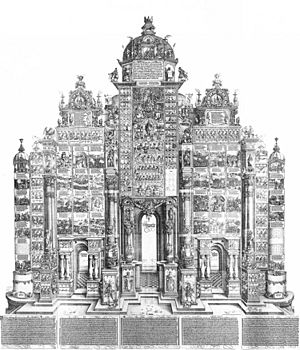
Roman triumphal arches remained interesting long after Rome fell. They reminded people of past glories and showed state power. At Lorsch Abbey, the Torhalle (gatehouse) was built to look like a Roman triumphal arch. This showed a link between the Carolingian Empire and old Rome.
It was during the Renaissance that rulers really started building their own arches. They wanted to connect themselves to the Roman past. One of the first was the "Aragonese Arch" at the Castel Nuovo in Naples. It was built by Alfonso V of Aragon in 1443. By the late 1500s, triumphal arches were used in royal events and military forts. The arch design was also added to public buildings like city halls and churches.
Temporary triumphal arches were often made for royal visits. These were usually built from wood and plaster. Unlike Roman arches, Renaissance rulers often built a line of arches for parades. These arches marked special spots where certain messages were shared. For example, new popes would walk through temporary arches in Rome. Arches were also built for royal weddings. When Charles Emmanuel I, Duke of Savoy married Infanta Catherine Michelle of Spain in 1585, he walked under arches that showed his family's long history.
Even pictures of arches became important. Temporary arches were taken down after use. But detailed drawings of them were made into engravings. These pictures were shared widely. They allowed people to study the stories and messages on the arches. Sometimes, the arches in the pictures weren't even real. They were just imaginary designs for royal messages.
A famous example is the Ehrenpforte Maximilians I by Albrecht Dürer. Emperor Maximilian I ordered it. It was one of the largest prints ever made. It was about 3.75 meters (12 feet) high. It had 192 separate sheets. It showed an arch that was never meant to be built. About 700 copies were printed. They were colored and put on the walls of city halls or palaces.
The French were leaders in building new permanent triumphal arches. The ambitions of the Bourbon kings and Napoleon Bonaparte led to many arches being built. The most famous arch from this time is the Arc de Triomphe in Paris. It was built from 1806–36. It looks different from Roman arches because it doesn't have the usual decorative columns. This makes it look "top-heavy." Other French arches copied Roman ones more closely. For example, the Arc de Triomphe du Carrousel in Paris looks like the Arch of Septimius Severus in Rome.
Triumphal arches are still built today. They are often used by dictators to show their power. Adolf Hitler planned to build the world's largest triumphal arch in Berlin. It would have been huge, big enough for the Arc de Triomphe to fit inside 49 times. It was meant to have the names of Germany's 1.8 million dead from World War I. But it was never built. North Korea's dictator Kim Il Sung built the world's largest triumphal arch in Pyongyang in 1982. It was designed to be much bigger than the Arc de Triomphe in Paris. It stands where Kim Il Sung gave his first public speech in 1945. It has sculptures showing "the victorious Great Leader returning to the country."
The design of the triumphal arch has also been used for other purposes. These include large memorial arches and city gates. Examples are the Brandenburg Gate in Berlin and the Washington Square Arch in New York City. Another is Barcelona's Arc de Triomf, built as an entrance to a fair. These arches look like triumphal arches. But they were built for different reasons. They might remember war dead, celebrate a civil event, or be a grand entrance to a city. They are not built to celebrate a military victory or a general.
- Triumphal arches built after Roman times
-
The Arco di Trionfo di Castel Nuovo in Naples. It's a Renaissance monument built to celebrate Alfonso of Aragon entering Naples.
-
The Porte Saint-Denis in Paris, built to celebrate the victories of Louis XIV of France.
-
The Arc de Triomphe du Carrousel in Paris, built in 1806–1808 to celebrate Napoleon's victories.
-
The Narva Triumphal Arch in Saint Petersburg by Giacomo Quarenghi. It was built in 1814 to celebrate Russia's victory over Napoleon.
-
The Wellington Arch in London, built in 1826–1830 to celebrate Britain's victories in the Napoleonic Wars.
-
The Soldiers' and Sailors' Arch in New York City, built in 1889–1892. It celebrates the United States' victory in the Civil War.
-
The Arcul de Triumf in Bucharest, built in 1922. It celebrates victory in WWI and the crowning of King Ferdinand and Queen Marie.
-
The Arch of Triumph in Pyongyang. It's the second tallest triumphal arch in the world. It was built in 1982 to celebrate the Korean resistance to Japan.
More to Explore
See also
 In Spanish: Arco de triunfo para niños
In Spanish: Arco de triunfo para niños



